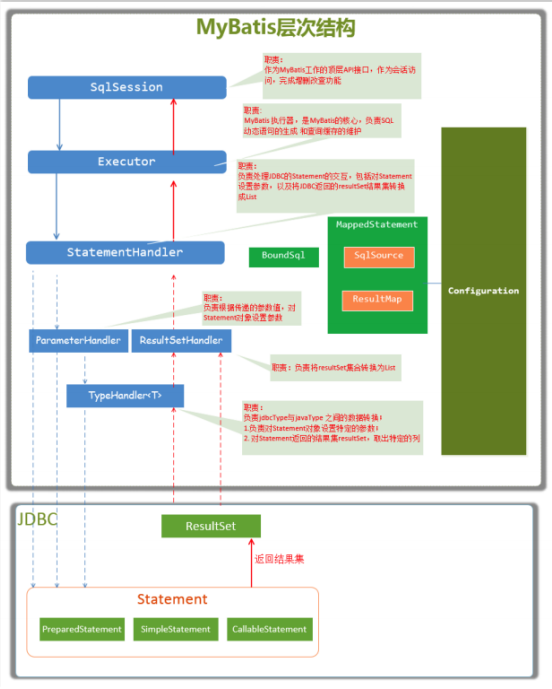Mybatis初始化过程
Mybatis初始化过程
// 1. 读取配置文件,读成字节输入流,注意:现在还没解析
InputStream resourceAsStream = Resources.getResourceAsStream("sqlMapConfig.xml");
// 2. 解析配置文件,封装Configuration对象 创建DefaultSqlSessionFactory对象
SqlSessionFactory sqlSessionFactory = new SqlSessionFactoryBuilder().build(resourceAsStream);

1.读取配置文件,读成字节输入流
//Resources.java
public static InputStream getResourceAsStream(String resource) throws IOException {
return getResourceAsStream(null, resource);
}
public static InputStream getResourceAsStream(ClassLoader loader, String resource) throws IOException {
InputStream in = classLoaderWrapper.getResourceAsStream(resource, loader);
if (in == null) {
throw new IOException("Could not find resource " + resource);
}
return in;
}
通过classLoad调用
getResourceAsStream()方法返回字节输入流,也就是得到了配置文件的字节输入流
2. 解析配置文件,封装Configuration对象 创建DefaultSqlSessionFactory对象
2.1 解析配置文件
SqlSessionFactory sqlSessionFactory = new SqlSessionFactoryBuilder().build(resourceAsStream);
//SqlSessionFactoryBuilder.java
// 1.我们最初调用的build
public SqlSessionFactory build(InputStream inputStream) {
//调用了重载方法
return build(inputStream, null, null);
}
// 2.调用的重载方法
public SqlSessionFactory build(InputStream inputStream, String environment, Properties properties) {
try {
// 创建 XMLConfigBuilder, XMLConfigBuilder是专门解析mybatis的配置文件的类
XMLConfigBuilder parser = new XMLConfigBuilder(inputStream, environment, properties);
// 执行 XML 解析
// 创建 DefaultSqlSessionFactory 对象
return build(parser.parse());
} catch (Exception e) {
throw ExceptionFactory.wrapException("Error building SqlSession.", e);
} finally {
ErrorContext.instance().reset();
try {
inputStream.close();
} catch (IOException e) {
// Intentionally ignore. Prefer previous error.
}
}
}
1.传入配置文件的字节输入流,调用其重载方法。
2.创建 XMLConfigBuilder对象,它是用来解析mybatis的配置文件的类
3.执行parser.parse()
parser.parse()
//XMLConfigBuilder.java
/**
* 解析 XML 成 Configuration 对象。
*
* @return Configuration 对象
*/
public Configuration parse() {
// 若已解析,抛出 BuilderException 异常
if (parsed) {
throw new BuilderException("Each XMLConfigBuilder can only be used once.");
}
// 标记已解析
parsed = true;
///parser是XPathParser解析器对象,读取节点内数据,<configuration>是MyBatis配置文件中的顶层标签
// 解析 XML configuration 节点
parseConfiguration(parser.evalNode("/configuration"));
return configuration;
}
parse():
判断是否解析过,抛出异常或打标记
4.调用parseConfiguration()方法,开始解析XML configuration 节点,并返回configuration
//XMLConfigBuilder.java
/**
* 解析 XML
* 具体 MyBatis 有哪些 XML 标签,参见 《XML 映射配置文件》http://www.mybatis.org/mybatis-3/zh/configuration.html
* @param root 根节点
*/
private void parseConfiguration(XNode root) {
try {
//issue #117 read properties first
// 解析 <properties /> 标签
propertiesElement(root.evalNode("properties"));
// 解析 <settings /> 标签
Properties settings = settingsAsProperties(root.evalNode("settings"));
// 加载自定义的 VFS 实现类
loadCustomVfs(settings);
// 解析 <typeAliases /> 标签
typeAliasesElement(root.evalNode("typeAliases"));
// 解析 <plugins /> 标签
pluginElement(root.evalNode("plugins"));
// 解析 <objectFactory /> 标签
objectFactoryElement(root.evalNode("objectFactory"));
// 解析 <objectWrapperFactory /> 标签
objectWrapperFactoryElement(root.evalNode("objectWrapperFactory"));
// 解析 <reflectorFactory /> 标签
reflectorFactoryElement(root.evalNode("reflectorFactory"));
// 赋值 <settings /> 到 Configuration 属性
settingsElement(settings);
// read it after objectFactory and objectWrapperFactory issue #631
// 解析 <environments /> 标签
environmentsElement(root.evalNode("environments"));
// 解析 <databaseIdProvider /> 标签
databaseIdProviderElement(root.evalNode("databaseIdProvider"));
// 解析 <typeHandlers /> 标签
typeHandlerElement(root.evalNode("typeHandlers"));
// 解析 <mappers /> 标签
mapperElement(root.evalNode("mappers"));
} catch (Exception e) {
throw new BuilderException("Error parsing SQL Mapper Configuration. Cause: " + e, e);
}
}
这些都是mybatis配置文件中的标签,开始逐个解析,注意最后一行 mapperElement(root.evalNode("mappers"))
说明在解析config*.xml的同时也解析了mapper.xml(映射配置)文件
一个映射配置文件中的每一个select、delete、update、insert都会封装成一个MappedStatement
2.2.创建DefaultSqlSessionFactory对象
return build(parser.parse());
public SqlSessionFactory build(Configuration config) {
return new DefaultSqlSessionFactory(config); //构建者设计模式
}
5.执行build方法,接收到封装好的
Configuration对象,并根据这个对象构建一个DefaultSqlSessionFactory。DefaultSqlSessionFactory就是一个SqlSessionFactory的实现类。构建者设计模式:当构建一个复杂的对象时 可以把他拆成构建个很多的简单的对象,再由多个简单的对象构成复杂的对象
本文来自博客园,作者:邓晓晖,转载请注明原文链接:https://www.cnblogs.com/isdxh/p/13994822.html


